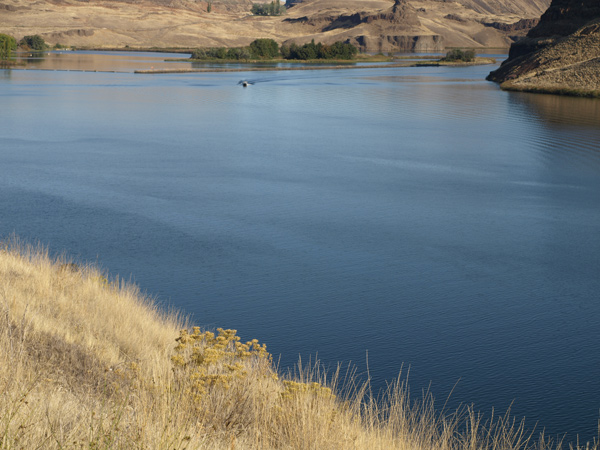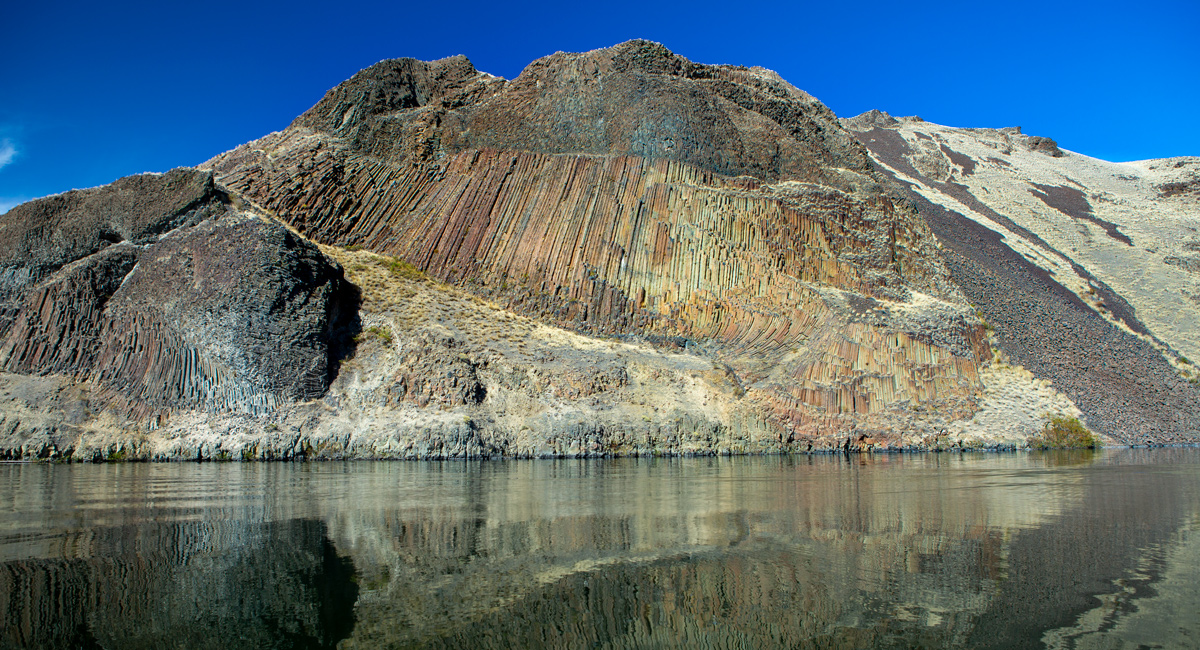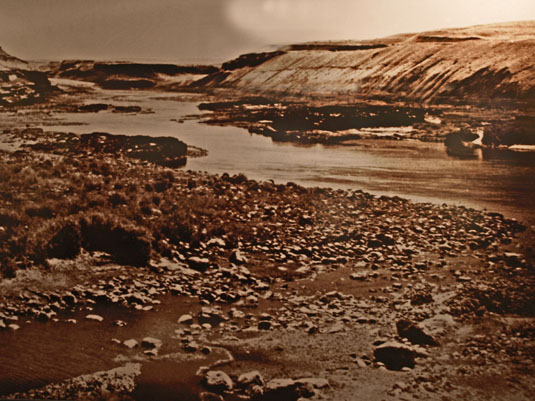Near Ayer, WA To start the day, the non-swimmers portage rifles and scientific equipment while the boatmen navigate a long Snake River rapid. In the evening, they run a two-mile rapid which “ran like a mill race.” In Santa Fe, a Spanish governor gives instructions to stop the expedition from returning.
All Canoes Safe[1]Originally aired weekdays by Yellowstone Public Radio during the Bicentennial observance of 2003-2006. Narrated by Hal Hansen. Scripts by Whit Hansen and Ed Jacobson. Produced by Leni Holliman. © … Continue reading
Columnar Basalt near Ayer
© 4 October 2014 by Kristopher K. Townsend. Permission to use granted under the Creative Commons Attribution-Share Alike 4.0 International license.
In 1805, reflections in the Snake River like the one shown above would have been rare. The river has been tamed by a series of dams designed to provide water navigation between the Columbia River and Lewiston, Idaho. All the rapids described in the journals are now inundated.
Morning Rapid
Above: The Palouse River enters from bottom left. The camera is on the north shore of the Snake looking upstream at the end of Ordway’s “mill race.” The large sandbank across the river is the vantage point of the photograph below.
Mouth of the Palouse Today

© 11 October 2008 by Kristopher K. Townsend. Permission to use granted under the Creative Commons Attribution-Share Alike 4.0 International license.
The rocky shores and and “mill race” are inundated by the slackwater behind Lower Monumental Dam.
the rained Seased & wind luled, and Capt Lewis with two Canoes Set out & passed down the rapid The others Soon followed and we passed over this bad rapid Safe. We Should make more portages if the Season was not So far advanced and time precious with us
—William Clark
Portaging Rifles and Instruments
all the men which could not Swim went by land and carried Some rifles & Instruments &c. we got Safe below the rapids by 12 oClock. dined on Sammon [salmon] and proceeded over Several more rapids the wind hard a head.
—Joseph Whitehouse
Tucannon and Palouse Rivers
S. 70° W 3 miles to a large Creek [Tucannon River] in the Ld. bend. passed a bad rockey rapid at 2 miles many rocks
N. 50° W. 5 miles to a large Creek [Palouse River] Std. bend passed a bad rapid for 4 miles
—William Clark
A Mill Race
towards evening we passed through a place in the River where it was all confined in a narrow channel of about 15 yards wide for about 2 miles and ran like a mill race
—John Ordway
Great Fishery
here is great fishing place, the timbers of Several houses piled up, and a number of wholes of fish, and the bottom appears to have been made use of as a place of deposit for their fish for ages past
—William Clark
Weather Diary
Day of the month Wind State of the Weather 13th S W. fair after rain Note from the 7th to the 16th octr. we were decending Kooskooske [Clearwater] & Lewises [Snake] river
rained moderately from 4 to 11 a M. to day.
—William Clark[2]Some abbreviations have been spelled out.
Alencaster’s Instructions to Vial
[13 October 1805]
Instructions to which Don Pedro Vial and the interpreter José Chalvert [Javet] of the Pawnee Nation, Otos, Logos, and any others of those located in the environs of the Rivers Missouri, Kansas, Platte, and Arkansas must conform to acquire news and knowledge of the state of Captain Merri’s expedition on the Missouri River . . . .
12. Vial will bear in mind the interesting confidential charge that I have entrusted to him, for which accomplishment he will not omit any necessary step . . . .
Joaquin Del Real Alencaster.[3]Guerra y Marina, leg. 1787–1807, exp. 15 (Library of Congress copy) in Noel M. Loomis and Abraham P. Nasatir, Pedro Vial and the Roads to Sante Fe (Norman: University of Oklahoma Press, 1967), 430, … Continue reading
Notes
| ↑1 | Originally aired weekdays by Yellowstone Public Radio during the Bicentennial observance of 2003-2006. Narrated by Hal Hansen. Scripts by Whit Hansen and Ed Jacobson. Produced by Leni Holliman. © 2003 by Yellowstone Public Radio. |
|---|---|
| ↑2 | Some abbreviations have been spelled out. |
| ↑3 | Guerra y Marina, leg. 1787–1807, exp. 15 (Library of Congress copy) in Noel M. Loomis and Abraham P. Nasatir, Pedro Vial and the Roads to Sante Fe (Norman: University of Oklahoma Press, 1967), 430, 432. |


